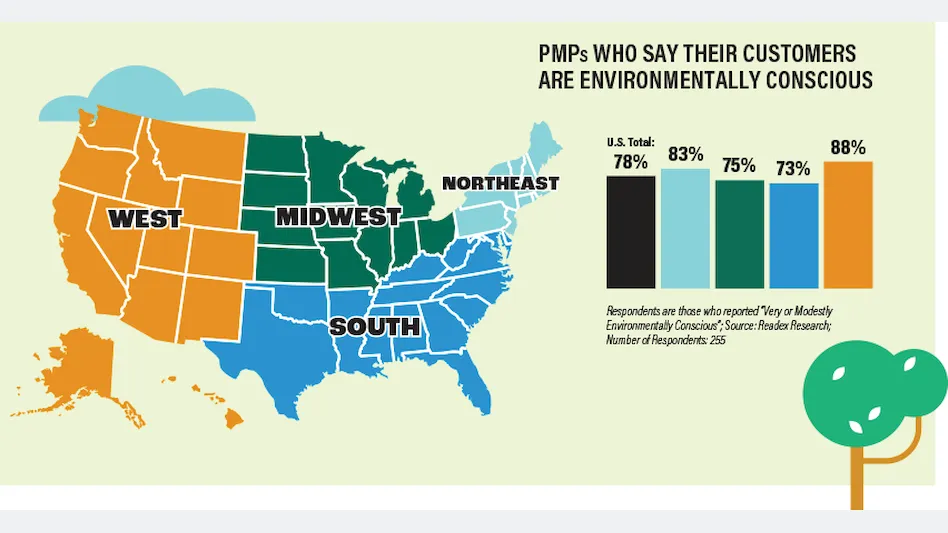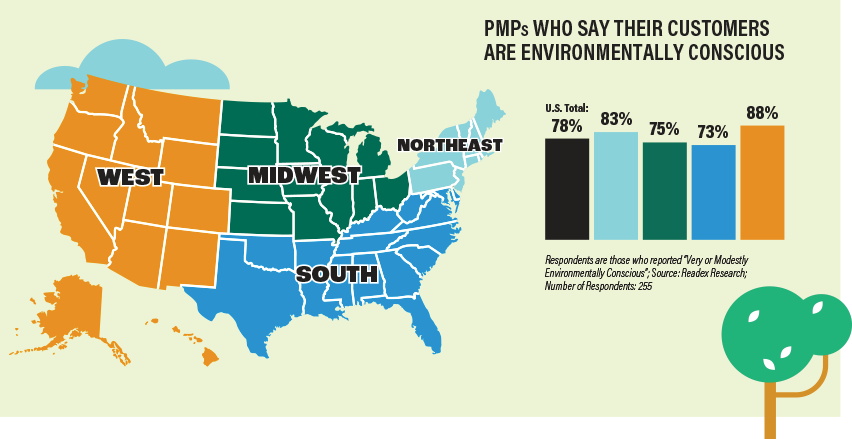

PCT’s annual State of the Naturals Market survey turned up some interesting results this year. Pest management professionals continue to believe in the importance of providing customers with the safest pest control programs possible while delivering results that keep them coming back. PMPs are also closely monitoring market trends — namely public attitudes toward environmental responsibility.
Across the nation, 78 percent of PMPs say that customers in their markets are very or modestly environmentally conscious. In the West and Northeast, that number rises to 88 percent and 83 percent, respectively.
NORTHEAST
“I have found that coastal communities tend to be more environmentally conscientious,” says Mike Travers of EcoGeek Pest & Termite Control in Sandwich, Mass. “In our market area, we’ve observed a strong environmental movement and a growing awareness about the impact of harmful chemicals on human health and the environment. This has led to a significant increase in the demand for natural pest control solutions.”
Regulations and policies that support environmentally friendly practices play a role in the Northeast as well, adds Travers, who says that roughly 95 percent of the products his company uses are organic. “Our IPM approach works well with eco-friendly products; we turn to conventional products only when there are no other viable options — in situations where an infestation has already reached a critical level and immediate action is required to prevent further damage, for example.”
Travers’ 95 percent green-product usage is a far cry from the national average and even the Northeast average. Nationwide, PMPs report that 17 percent of the products they use are green; in the Northeast, it’s 24 percent. The Midwest checks in at almost 19 percent, with the South and West each reporting 15 percent.
SOUTH
“We don’t see widespread demand for green services,” says Chad Highley of Environmental Pest Control in Lawton, Okla. “We come across accounts now and then where a customer requests a green solution — a chiropractic clinic, certain pet owners and others who appreciate the offering — but for the most part, demand seems to be holding steady rather than increasing.”

WEST
Bob Gordon agrees that the type of account plays a role in what customers are looking for. Gordon Termite Control services a lot of apartment and condo complexes in Los Angeles, for example, and those property management companies tend to be more concerned with cost and effectiveness than with the nature of the products used. Conversely, school accounts require the use of natural products, and Gordon is happy to comply.
“For us, being flexible enough to meet the needs of our varied customers has been key,” he says. “Once you understand your customer’s priorities, you can develop an effective program for them. Whether that’s a property manager looking to contain costs, a school looking to protect students or a resident who either does or doesn’t see the value in paying more for green services, you need to have options that make them comfortable with the services they’re receiving.”
MIDWEST
In Michigan, Daniel Feig of Advantage Pest Services says that most of his customers are environmentally conscious. “They want to make sure they’re protecting themselves, their kids, their gardens and their lawns. The first thing most people ask is, ‘Will it be harmful to us or the environment?’” he says. “Property managers are asking for green solutions more often, too. One of the companies I work with manages student housing, and they made sure from the start that I wouldn’t use anything toxic. My approach for every account is to use as little material as possible to get the job done.”
NATIONWIDE
Sam Soto of First Rate Pest Solutions weighs in with the New York perspective, which seems to apply to the entire country: “For the people who care, they care a lot. Not everyone may be environmentally conscious just yet, but the number who are is growing and they are adamant about wanting green solutions. It’s our job to provide those for them.”

Explore the April 2023 Issue
Check out more from this issue and find your next story to read.
Latest from Pest Control Technology
- SiteOne Hosts 2024 Women in Green Industry Conference
- Veseris Celebrates Grand Reopening of the Miami ProCenter
- Rollins' 2024 Second Quarters Revenues up 8.7 Percent YOY
- Fleetio Go Fleet Maintenance App Now Available in Spanish
- German Cockroach Control Mythbusting
- Total Pest Control Acquires Target Pest Control
- NPMA Workforce Development Shares Hiring Updates
- Certus Acquires Jarrod's Pest Control





